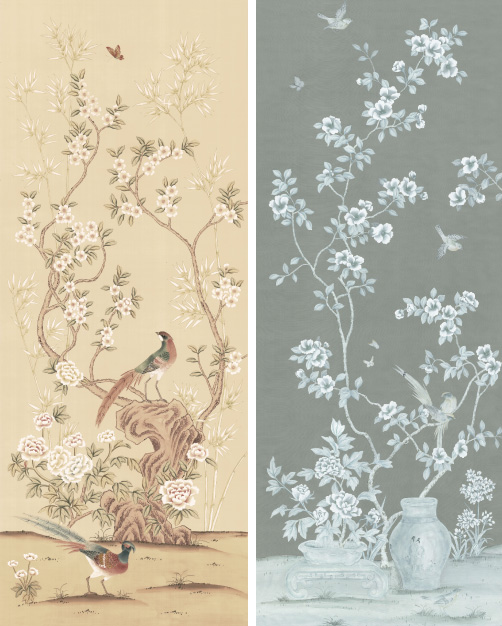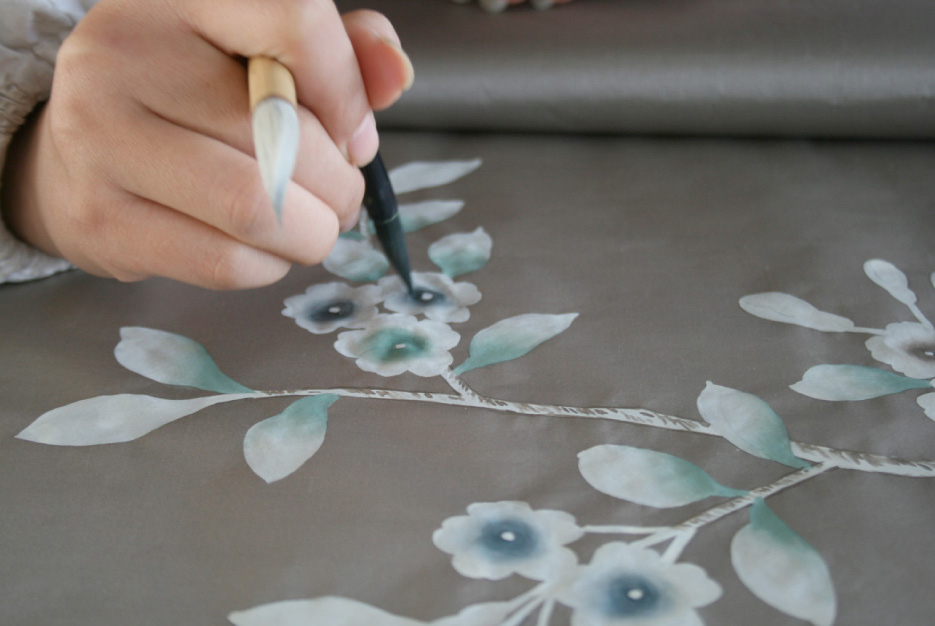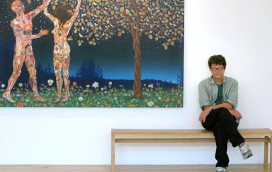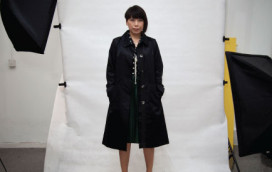Peeking through a door into a warehouse in the ancient city of Wuxi on the coast of central China, the scene within could be one from the 19th century. In a large, light-filled room, dozens of artists are bent over rows of long white tables, each slowly and methodically dipping long, slender brushes into small porcelain dishes of gouache paint and then carefully applying it to a flat panel of silk.
The workers – some of the most accomplished painters in China – are creating hand-made silk wallpaper. Theirs is a highly skilled and painstaking craft, and with their heads bent and brows furrowed in concentration, they will employ as many as 100 brush strokes to create one leaf and spend up to an hour delicately shading the wings of a bird.
To create enough wallpaper to cover the walls of a single room will take them many hundreds of hours. But in a week they will have created something that is spectacular and utterly unique: a grand hand-painted mural, some 100ft wide, featuring the most dazzling backdrop of swooping birds, gnarled trees and vibrantly colored flowers.
In painting these eye-catching designs the artists are following an ancient tradition, for it is in Wuxi, and also the neighboring city of Suzhou, that the heart of China’s hand-painted silk industry has been based for the past 1,500 years. Once this artform meant scrolls and screens for China’s wealthy governing Mandarin class and its richer merchants, their designs symbolic displays of rank; a blazing dragon denoted power, a flowering peony wealth and beauty. But in the 18th century, these beautifully detailed designs of birds, flowers, trees and pastoral scenes were discovered by Western merchants, who ordered them to be painted on to silk to create wallpaper for export to Europe and America. In the midst of the craze in Europe for chinoiserie (from chinois, the French word for Chinese), the paper quickly became fashionable. It was transported on the ships of the East India Company and formed a significant part of China’s export trade to the West. Today, visit any number of historic stately homes in Europe or North America, and it’s likely that you will come across at least one wall in each that’s embellished with this fine Chinese art.
The Chinese company Griffin & Wong, established in 2007 as a collaboration with the descendants of the original Suzhou Silk-Workers Craftsman Guild, often refers back to homes of America’s Gilded Age for inspiration: mansions such as Marble House and Rough Point in Newport, Rhode Island, both owned by the Vanderbilts, Villa Vizcaya in Miami and the Winterthur Mansion in Delaware.
“The chinoiserie in these buildings is an interesting reflection of the stylish decades either side of the turn of the century,” says Douglas Bray, MD for Griffin & Wong in the Americas. “This was the Art Nouveau era when the wealthy lived in the grand hotels of New York and Florida for parts of the season, and then had the ambition and wealth to try to recreate the fantasy of a dramatic hotel lobby in their own homes. For the interior design world it was a golden time, and chinoiserie was a great part of the Gilded Age.”
Although in the latter part of the 20th century China’s Communist revolution, combined with the rise of Minimalism in the West, put a dampener on this exuberant form of decoration, it is now enjoying a resurgence in popularity. Chinoiserie is newly popular not only in fashionable circles, reflecting a trend in pattern and design, but in architectural practices, too, which appreciate the intrinsic value of historic artisanal craft and the bespoke element it contributes.
“While hand-painted wallpaper used to be very much a limited, high-society product for the Manhattan and London crowds, it is more widespread now,” says Bray. “The oligarchs in Russia love it, as do the upper echelons in Dubai and Saudi Arabia. Even in places like South and North Carolina it has become very popular.”
Ironically, although produced in China for the West, it was almost unknown across wider China until about a decade ago. That, though, says Bray, is also changing fast. “The arc has been first for the hotels and high-end restaurants to commission and show the wallpapers, and then recently for the ultra-wealthy – a class that’s growing – to install it in their own villas and residences.”
The corresponding increase in demand for the skills of hand-painting has revitalized a craft that had been in danger of dying in a rapidly industrialized China. “Studios are popping up all the time and this is making it harder to find good artists,” says Tim Butcher from Fromental, a wallpaper company which has a large atelier in Wuxi with about 50 artists working in it. “All Fromental staff are skilled before they begin, but they start as apprentices and work their way up.”
It can take years to reach the top of their profession. Hand-painted wallpaper is still produced in much the same way as it has been for centuries. Unlike printed paper, which usually features one pattern that is repeated, chinoiserie typically consists of a single mural on a series of panels, presenting a panorama of Chinese flora and fauna. Each element is chosen for its symbolic meaning in the relationship between the concepts of Harmony and Nature.
Manufacture is a time-consuming process. First, the silk is treated with a hardening glue before it is stretched on a frame, ready for the design to be sketched by hand with a fine pencil. Then the painting begins. “Four or five artists work on each set,” explains Butcher, whose clients include Chanel and the entrepreneur David Tang, and who for The St. Regis Jakarta, which opens in spring 2016, is creating chinoiserie panels for the bedrooms. “Within any team there is a lead artist and usually an apprentice. The junior artists will paint in the first flat layer of color. The more experienced ones will then start adding in more detail such as shading, the veins on leaves or the petals of a flower. Finally, the finer details of shading will be added on to the birds and the tips of the flowers.”
The supreme expression of the craft is “unconscious painting”, a more spontaneous style of artistry in which a tree trunk is created with a single brush stroke. “It requires speed so that the end result looks natural,” says Butcher. “It is a given that an artist can produce fine, controlled brushwork, but the ability to create balance and form with loose and free strokes of the brush is a skill that’s harder to achieve.”
It is the painstaking building up, layer by layer, of pattern and color that gives painted silk wallpaper its exceptional depth and texture. On close inspection, the artist’s skill is revealed in the play of light and shade against the lustre of the silk, and the intricacies of the individual elements, from the folds of a dress to a bird’s multicolored tailfeathers.
This precision and detail is reflected in the cost. According to Virginia-based Paul Montgomery, who has 35 artists in China creating finely painted backdrops for clients who range from Hollywood celebrities to Middle Eastern royalty, hand-painted wallpaper starts at about $500 for a square yard. And yet considering the paper is unique, it can be thought of as an investment, he says, because it is also surprisingly practical. Not only does silk wallpaper make a room warmer and more personal, it also softens the acoustics.
While painted panels are the most popular with clients, Fromental has recently pioneered the complex skill of embroidering on paper, to create a striking three-dimensional look. “If it takes 30 hours to paint one panel, to fully embroider the same panel takes 300 hours,” says Butcher. “It needs a remarkable level of skill because the tension has to be completely even.” This can be embellished further with the addition of gems, crystals and precious metals.
Although technology has enabled murals to be as lavishly decorative as any client might want, a trend is emerging for hand-painted wallpaper whereby texture, rather than elaborate pattern, is the key attraction. “People still value the hand-painted and artisanal, but they want something that is simpler,” says Butcher. “So we created papers that are done with layered brush strokes for a gradation of pattern and deep color.” Often resembling an abstract painting, these hand-painted wallpapers are a superb fusion of old and new, and work even in the sharpest of contemporary interiors – gratifying evidence that there is still a place for time-honored craft in today’s design universe.
Griffinandwong.com; fromental.co.uk; paulmontgomery.com
Your address: The St. Regis Jakarta, opening spring 2016





